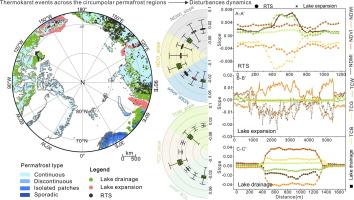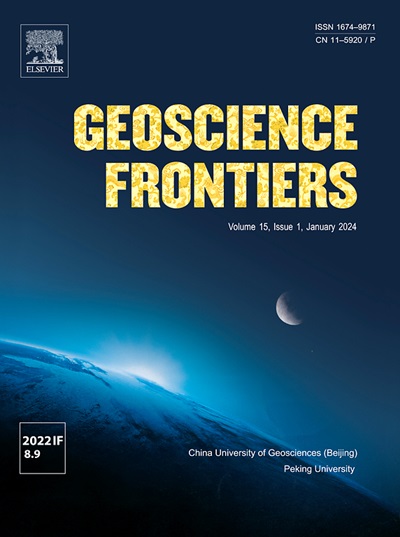1990 - 2023年环极多年冻土区热岩溶扰动对气候变化的响应
IF 8.9
1区 地球科学
Q1 GEOSCIENCES, MULTIDISCIPLINARY
引用次数: 0
摘要
气候变暖导致多年冻土退化,形成严重的热岩溶扰动,对地貌、水文和生态过程产生重大影响。然而,对热岩溶扰动及其下一步发展的长期监测仍然是整个极地多年冻土区的一个挑战。在此基础上,我们利用Landsat图像计算了代表绿度、湿度和亮度的6个光谱指数,量化了热岩溶景观动态的时空特征,并进一步揭示了它们随气候变暖的发展。利用谷歌Earth Engine平台上的LandTrendr算法,选择DNMI、NDWI和NDVI来验证退行性融塌、热岩溶湖扩张和排水的发生和严重程度。三种主要热岩溶事件表现出一致的扰动年,与2000年左右的夏季增温点相关。二者的相关分析还表明,热岩溶扰动的后续景观发展与气候变暖背景有关,表现为植被绿化和土壤湿润趋势。这些发现突出了1990 - 2023年热岩溶扰动的动态特征,为全面了解气候变化下的热岩溶发育提供了依据。本文章由计算机程序翻译,如有差异,请以英文原文为准。

Thermokarst disturbance responses to climate change across the circumpolar permafrost regions from 1990 to 2023
Warming climate drives permafrost degradation and forms serious thermokarst disturbances, with significant impacts on geomorphology, hydrology, and ecological processes. However, the long-term monitoring of thermokarst disturbances and their next development remains a challenge across the circumpolar permafrost regions. Here, we calculate six spectral indices from Landsat images to represent greenness, wetness, and brightness, quantifying the spatiotemporal characteristics of thermokarst landscape dynamics and further revealing their development with a warming climate. Additionally, DNMI, NDWI, and NDVI are selected to verify the occurrence and severity of retrogressive thaw slumps, thermokarst lake expansion, and drainage by the LandTrendr algorithm on the Google Earth Engine platform. Three major types of thermokarst events show a consistent disturbance year, correlating with the summer temperature increase point around 2000. Their correlation analysis also reveals that the subsequent landscape development of thermokarst disturbances is related to the warming context, showing vegetation greening and soil wetting trends. These findings highlight the dynamic characteristics of thermokarst disturbances from 1990 to 2023, providing a comprehensive understanding of thermokarst development under a changing climate.
求助全文
通过发布文献求助,成功后即可免费获取论文全文。
去求助
来源期刊

Geoscience frontiers
Earth and Planetary Sciences-General Earth and Planetary Sciences
CiteScore
17.80
自引率
3.40%
发文量
147
审稿时长
35 days
期刊介绍:
Geoscience Frontiers (GSF) is the Journal of China University of Geosciences (Beijing) and Peking University. It publishes peer-reviewed research articles and reviews in interdisciplinary fields of Earth and Planetary Sciences. GSF covers various research areas including petrology and geochemistry, lithospheric architecture and mantle dynamics, global tectonics, economic geology and fuel exploration, geophysics, stratigraphy and paleontology, environmental and engineering geology, astrogeology, and the nexus of resources-energy-emissions-climate under Sustainable Development Goals. The journal aims to bridge innovative, provocative, and challenging concepts and models in these fields, providing insights on correlations and evolution.
 求助内容:
求助内容: 应助结果提醒方式:
应助结果提醒方式:


